Guidebook: Mobilising private sector finance for climate change adaptation
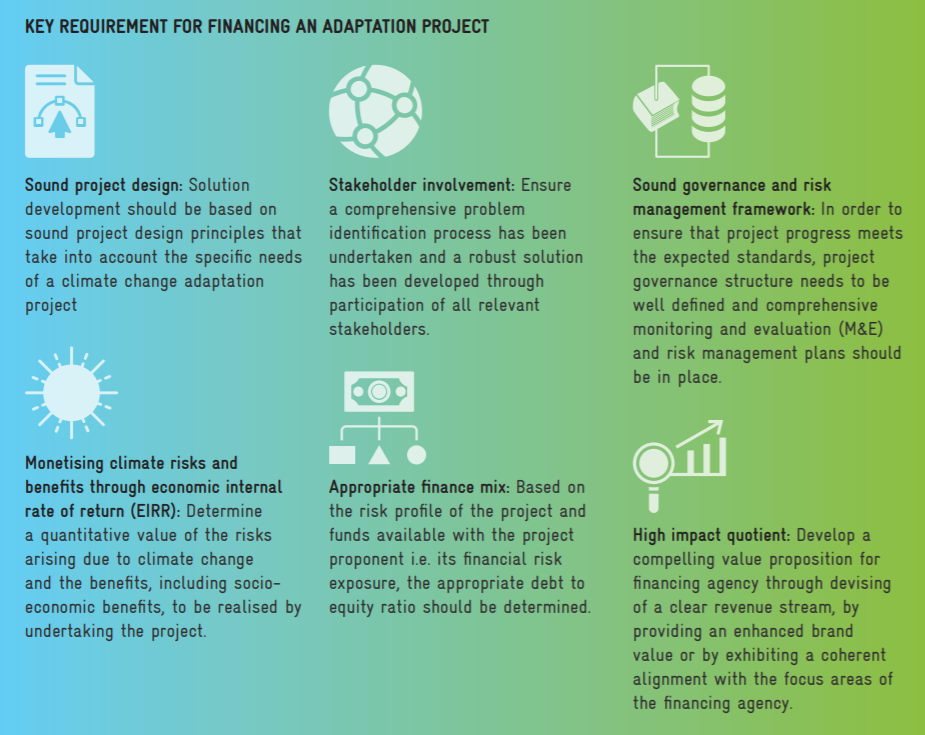
Introduction
The manifestation of climate change i.e. a climate shock or stress, may lead to adverse effects that have direct and indirect impact on human beings and surrounding ecosystems. Climate change adaptation interventions lead to adjustment in natural or human systems which help in responding to such manifestations or their effects. These interventions moderate the harm arising from climate change or exploit the beneficial opportunities. Traditionally adaptation interventions have been financed by the public sources and rarely taken up by the private sector. This phenomenon is related to the “Development-Adaptation Continuum” which is a spectrum from ‘pure’ development activities on one end to very explicit adaptation measures on the other.
As we move from pure development interventions to pure adaptation interventions, we observe a reduction in clearly identifiable revenue streams. The lack of explicit revenue opportunities in adaptation projects thus reduces the propensity of the private sector in funding adaptation interventions. Apart from this inherent nature of adaptation projects, the private sector also faces multiple problems such as low bankability of adaptation projects, lack of standardised methodology amongst lenders to appraise adaptation projects, limited access to information to design and develop adaptation projects, limited capability in developing inclusive business models and issues with the political economy. Considering the scale of investment required for adaptation, it is imperative to increase participation of private sector and not leave the entire burden of investment on the public sector.
The guidebook* aims to achieve this objective by providing guidance in requisite tools and methodologies required for developing bankable adaptation projects along with information on alternate funding sources and investment models available to the private sector to mobilise funds for climate change adaptation.
*Download the full guidebook from the right-hand colum.
Summary
This guidebook has been drafted to resemble the typical three-stage approach which any adaptation project development process would follow. The flowchart given below provides the flow of activities from the project design to the implementation stage:
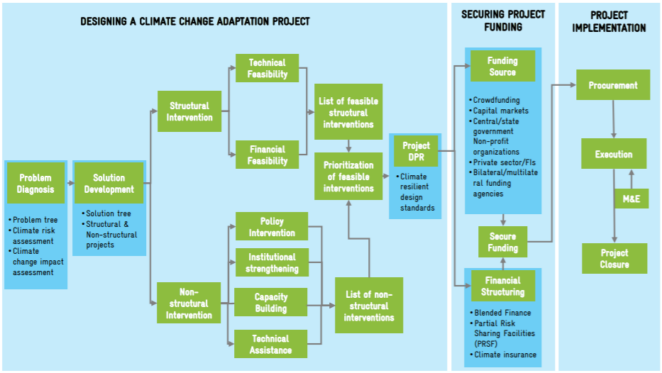
Each chapter of the guidebook details out the procedure proposed for project proponents to adopt while conceptualising and/or developing adaptation projects. At relevant sections, the guidebook consists of anecdotal references and best practices observed both in India and globally.
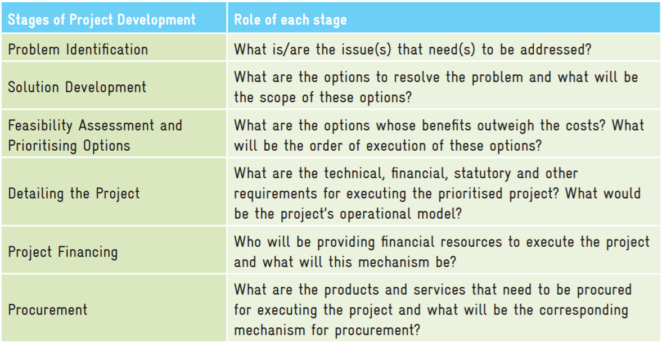
Key findings
1. Designing a climate change adaptation project
The genesis of any climate change adaptation project will be from a problem perception.
- This perception needs to be elaborated by means of a problem tree and validated by means of a climate risk assessment (figure 4).
- Once the core problem, issues and the effect have been identified, a solution tree needs to be developed to identify the solutions.
- Pertinent to the adaptation context, these solutions can be clustered in to structural or non-structural projects.
- While structural projects involve development of physical infrastructure, non-structural projects involve use of knowledge, practice or agreement (like policies, laws, training, institutional strengthening, and technical assistance) to address a particular adaptation issue.
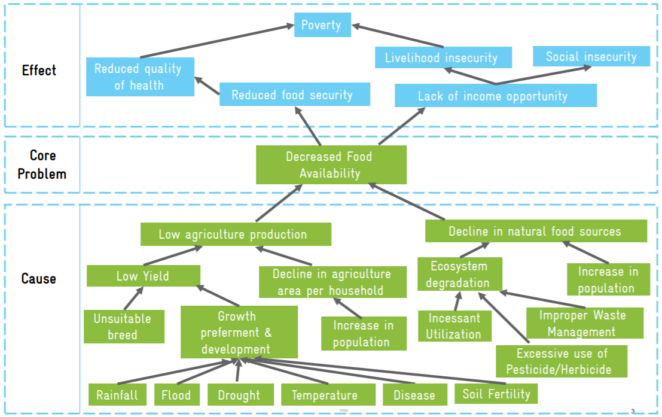
The project thus identified, needs to be tested for technical and financial feasibility (in case of structural projects) or socio-economic feasibility (in case of non-structural projects).
- During the feasibility assessment of project options, an operating model needs to be identified to the extent possible.
- The feasible solutions need to be prioritised to ascertain the sequence in which these projects need to be undertaken.
- As with any conventional project, a detailed project report (DPR) needs to be prepared to proceed to the next stage i.e. financing.
2. Securing project funding
In order to secure funds for the project, the guidebook prescribes the selection of an appropriate funding source as well as a funding mechanism.
- There is a diverse range of sources available for financing a bankable adaptation project, wherein the guidebook provides key information required to understand the requirements and limitations of these sources.
- Examples of such sources range from crowdfunding, central/state government funds/ schemes, capital market instruments, nonprofit organisations/funds, private sector and financial institutions (FIs) and bilateral/multilateral funding agencies.
- Apart from the case of self-financing, most of the aforementioned funding sources have seen to be reluctant to fund projects alone, even though feasibility has been established.
- This necessitates securing of funds from multiple sources and adopting an appropriate structuring of the funds to ensure risk normalisation.
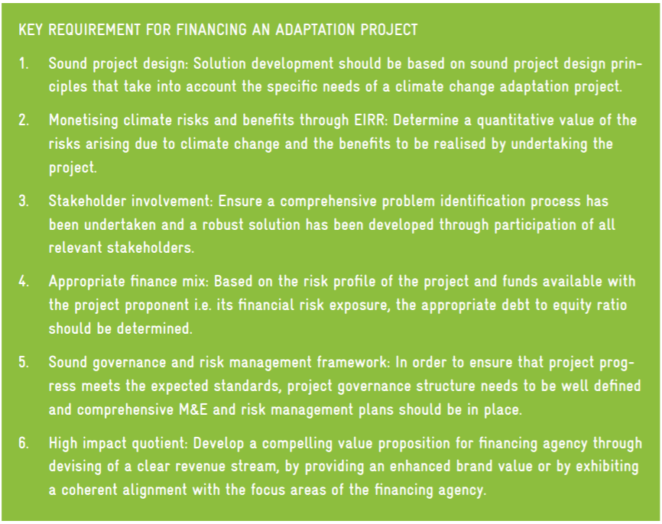
The guidebook provides guidance to the project proponents in the appropriate mechanism by which risk is normalised either by sharing the risk or increasing risk coverage viz. blended finance, partial risk sharing facilities (PRSF), insurance products.
3. Project implementation
The guidebook provides a concise step-by-step process outlining the procurement and implementation stages of project development (page 74), as highlighted by figure 6:

Lessons Learnt
Planning, designing, obtaining approval and finally executing an adaptation project requires cross-functional expertise. In most cases, it would be impossible for the project proponents to have an in-house source of such a wide gamut of expertise. Hence, it is recommended that the project proponents undertake investments in developing a good knowledge base as well as develop the vertical and horizontal sector linkages and coordination with non-government stakeholders (especially expert groups and the affected population) in order to design an effective project.
While all efforts have been undertaken to make the guidebook a good starting point for planning out an adaptation project, the project proponent must take into account the prevailing market conditions and regulatory landscape while referring to this guidebook. With a growing focus on private sector participation in adaptation projects, it is expected that new financing mechanisms might get developed over a period of time which may not have been captured in this document. However, it is envisaged that users of this guidebook will continually add the learning from their experience to further enrich this document and help making it a comprehensive reference document for developing climate change adaptation projects in India.
Suggested citation
Bandyopadhyay, A., Chatterjee, A., Banerjee, D., Awasthi, K., Bhatt, S., 2019. Guidebook: Mobilising private sector finance for climate change adaptation. DEUTSCHE GESELLSCHAFT FÜR INTERNATIONALE ZUSAMMENARBEIT (GIZ) GmbH.
Further reading
- Engaging the private sector in financing adaptation to climate change: Learning from practice
- Engaging the Private Sector in National Adaptation Planning Processes
- Business case for the Bangladeshi private sector to invest in climate change and access international climate finance
- The Roles of the Private Sector in Climate Change Adaptation – an Introduction
- Three key private finance initiatives for financing a 1.5°C target
- Private finance for adaptation in LDCs? Spelling out the options
(0) Comments
There is no content